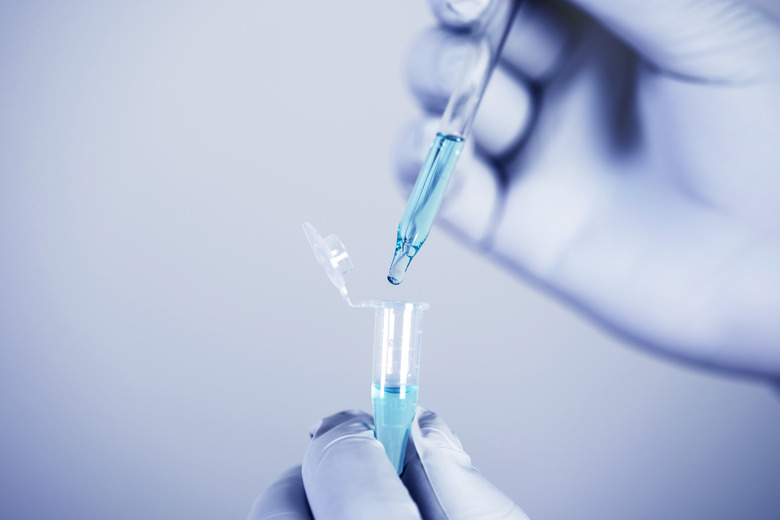Difference Between Attached & Detached Ribosomes
Cells are highly organized structures that perform a dizzying array of functions. One important cell task is to create proteins for use inside and outside the cell. The hardware for protein construction in a cell includes ribosomes. These little factories can float free in the cell's watery cytoplasm or attach to an organelle called the endoplasmic reticulum, or ER.
Born in the Nucleolus
Born in the Nucleolus
The cell assembles ribosomes in the nucleolus, a region within the nucleus. Construction calls for strands of ribosomal RNA, or rRNA, to join with certain proteins to form ribosome granules. The RNA is transcribed from genes on one or more DNA chromosomes with the assistance of enzymes called RNA polymerases. The RNA strands join with ribosomal proteins to form subunits for "export" out of the nucleus and into the cell body. Each ribosome is composed of a large and a small subunit. These subunits work together to translate messenger RNA into proteins.
Are You Attached?
Are You Attached?
Some of the ribosomes created attach to "rough" ER, which is a network of tiny membranes. A ribosome is not permanently affixed to one spot on the ER, but rather repeatedly attaches and detaches during the protein-making process. The function of the attached ribosomes is to create proteins for use by the cell membrane or for export to other parts of the body. The ribosome's large subunit encloses and reads a strand of messenger RNA. The smaller subunits tow and attach the corresponding amino acid to the growing length of protein. Some of these finished proteins exit the cell via a "secretory pathway."
You Seem So Detached
You Seem So Detached
Free, or detached, ribosomes float within the cell's intracellular fluid, or cytoplasm. They are free to move around anywhere other than the nucleus and other organelles. The detached ribosomes create proteins that are released directly into the cytoplasm for use by the cell. A peculiarity of cytoplasm is that it contains high concentrations of glutathione, a short protein segment containing the amino acid cysteine. This environment prohibits proteins with sulfur in the form of a disulfide bond from being made by the detached ribosomes.
Different Strokes
Different Strokes
The types of proteins made by the two different ribosome types differ in other ways beyond disulfide bonds. Detached ribosomes figure heavily in cellular metabolism and generate enzymes that release the energy from glucose molecules. Attached ribosomes make proteins targeted for specific purposes outside the cell, such as digestive enzymes used in the gut. They also produce hormones and certain cell membrane proteins that act as surface receptors. Much of the output from ribosomes travels to another cell organelle, the Golgi bodies, which sort and package the proteins for particular uses.
Cite This Article
MLA
Finance, Eric Bank, MBA, MS. "Difference Between Attached & Detached Ribosomes" sciencing.com, https://www.sciencing.com/difference-between-attached-detached-ribosomes-8805/. 13 March 2018.
APA
Finance, Eric Bank, MBA, MS. (2018, March 13). Difference Between Attached & Detached Ribosomes. sciencing.com. Retrieved from https://www.sciencing.com/difference-between-attached-detached-ribosomes-8805/
Chicago
Finance, Eric Bank, MBA, MS. Difference Between Attached & Detached Ribosomes last modified March 24, 2022. https://www.sciencing.com/difference-between-attached-detached-ribosomes-8805/
